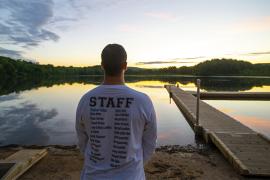I had made an early morning appointment with my chiropractor to help with some chronic lower back problems. Given my usual busy schedule, I made it for 8 a.m. — the first available appointment he offers in the morning — so I would have plenty of time to make it back to my office for a 9:30 a.m. appointment with a client of my own.
When I arrived at my chiropractor’s office at 7:59, I was greeted by his secretary. She asked me to have a seat and told me that “Dr. Jim” would be with me soon. At 8:15 I asked her calmly, “Is Jim here?”
She politely, though somewhat nervously, said, “He should be with you shortly.” Five minutes later I heard him walk through the back entrance of the office. I decided to have what author and former Apple University faculty member, Kim Scott, calls a “radically candid” conversation with Dr. Jim.
I seized the moment just as I entered the consultation room. “Jim, you and I have known each other for over 30 years. You’ve been a master at helping me manage my chronic lower back problems. I have referred some of my best friends and many of my own patients to you because of the quality of care that you give. I don’t think I have to tell you how grateful I am for all you’ve done for me.”
Dr. Jim was visibly moved. He offered his hand to me in a gesture of gratitude for what he knew was a sincere and heartfelt acknowledgment of his skill and care. As I let his hand go, I added, “That said, I have been waiting for you for over 20 minutes. I wouldn’t make an appointment at 8 o’clock if I didn’t need to be here that early to make the rest of my day run on time. If I make the commitment to be here on time, and I keep my end of the bargain, then I expect you to do the same. If you don’t plan on being here until 8:15 or 8:20, then don’t offer an 8 o’clock time slot to your patients. And you and I both know this is not the first time this has happened.” My tone of voice was even and calm. I was not being mean. I was being clear. I could see by the look on his face that Dr. Jim had gotten the message.
Radically Candid Conversations
Now, you might ask, what does my chiropractic appointment have to do with camp? Just this: How many times must you as a camp professional — director, assistant director, unit leader, head counselor, or program director — have challenging yet clarifying conversations with others? Camp is, after all, about growth, and growth is by definition trial and error. That means it is often painful, awkward, and challenging for everyone involved. The people you work with every day, whether they are staff, campers, colleagues, parents, board members, or even family members who work in the business with you, will never fail to give you some opportunity to have a badly needed radically candid conversation — one that Kim Scott describes as “personally caring and professionally challenging.” The conversation may be to clarify what the other person is doing that fails to meet expectations, or it may be about the ways in which they can more robustly step into strengths they are under using. Radically candid conversations are, indeed, at the heart of the work we all do at camp. They are about giving guidance (Scott, 2017).
There are many reasons why most of us hesitate to give others candid, clear, critical feedback, which is one hallmark of a radically candid conversation. It may be that we are afraid we will hurt the other person’s feelings, or that they will take it the wrong way and misunderstand our positive intentions. We may realize we have let things go on too long and may even have unintentionally misled the other person about their behavior or performance. We may have given them the false impression that their behavior or performance is better than it is, therefore fearing their backlash when we eventually set the record straight. We may even have let the conversation go so long that we are, in fact, angry about the situation and afraid we can’t separate our own feelings from anything we might say that could be constructive. Or we may simply be too close to the person, fear their power over us, or just not have the skill to make the conversation happen in a way that accomplishes anything positive. Thousands of camp professionals have told me as much over the years.
Pointers for Successful Radically Candid Criticism
Camp professionals can take several steps to venture more confidently and effectively into radically candid criticism.
- Start with a statement you can both agree on, say the authors of the book Crucial Conversations. This statement is your common ground. It might be how dedicated a staff member has been, how important camp has been for a staff member or camper, how far a camper or staff member has come since arriving at camp, how much parents want their child to succeed, and so forth. Beginning in this way helps keep both parties in alignment and warms everyone up. It is like saying, “This is what we both want” (Patterson, Grenny, McMillan, & Switzler, 2012).
- Validate the other person. There are at least six ways to validate someone, whether it is to validate their feelings, their experience, their effort, their positive intentions, their strengths, or even your contribution to the problem. (For more on this, refer to the Resources section of this article.)
- Refer to the contribution the other person has made or tried to make. With parents, it might be whatever they have done to encourage their child to try camp or what they have done to prepare their child for camp. For staff, it might be their supportive friendships with other staff, their sense of humor, or their effort at making things fun for their campers. This is called a “strength confrontation,” and from here you can challenge the other person to use that strength in ways they may not be — like building stronger relationships with campers.
- Make it clear that you care. In her book Radical Candor, Kim Scott talks about different ways that personal caring gives you credibility with the other person — something I have long referred to as “money in the bank” (Scott, 2017). (For more on the radically candid approach, refer to the Resources section of this article.)
- Be clear with your feedback. As Kim Scott says, being clear is not being mean — it is “giving guidance to people.” When you do this, include three essential ingredients, as follows: Situations where you observed the behavior; the behavior observed (what a person did or said); and the impact of that behavior, whether on campers, colleagues, you, them, etc. Give specific examples and avoid using labels (Scott, 2017).
- Keep it brief. Once you give clear feedback, which is another way of saying guidance, you need to keep it brief and to the point. When we get anxious or we are not clear ourselves, we get long-winded and verbose. This can be confusing and unnecessarily raise the other person’s anxiety level, making them defensive rather than receptive.
Saying Goodbye: A Particularly Painful Conversation
In his book, Necessary Endings, Henry Cloud looks at a specific example of a radically candid conversation — the one where you realize it is time to let a staff member go who has outlived his or her usefulness or who has stopped growing (Cloud, 2011). (I make a distinction here from the staff member you may need to let go who has violated a camp policy or compromised the camp community in some way.) This can be a particularly painful encounter, because we know that camp is often a safe place for many campers-turned-staff, or even for staff who have more recently found a home at camp. A particularly tender example of this is the camper with cancer, diabetes, hemophilia, colitis, etc., who thrives and is so successful and happy at camp that they stay on and become a staff member. For young people such as these, camp has been a safe haven — a place where they have come into their own and have grown tremendously because of the experience camp has offered them. How, I am frequently asked, can a camp professional who is empathic to the struggles of these young staff members let such people go, even if we feel they have stopped growing, are holding others back, or are out of step with the mission of camp?
The answer is by having a radically candid conversation with them. One critical aspect of this kind of life guidance is to acknowledge how camp has been good for them, and maybe even how they have been good for camp. The problem lies with counselors who stay at camp because they are avoiding the real world and the challenges and growth it can offer. As Cloud says, “When done well, ‘necessary endings’ allow people to foster growth, reach personal and business goals, and live better lives. When done poorly though, good opportunities are lost, and misery either remains or is repeated” (Cloud, 2011). I would add, “Growth is avoided.”
We all know counselors who can’t let go. Indeed, letting go is one of the most difficult things we as human beings do — and one of the most difficult things we will ask others to do. Yet letting go is precisely what opens a door to growth opportunities we may never see if we don’t make room for them, or help others make room for them. Indeed, it was the risk of first coming to camp as a novice — leaving our comfort zones over and over at camp — that resulted in all the growth camp could offer. What kind of mentors would we be if we did not give the radically candid guidance to even long-standing, highly regarded staff members and we failed to invite them to go out into the greater world? “You left your comfort zone once to come to camp and it paid great dividends. What kind of friend would I be if I didn’t push you to trust yourself and reach for all the strengths you have either gained or honed at camp to take on the greater world?”
Oh, and remember Dr. Jim, my chiropractor? At the end of our appointment he stopped for one moment and said, “I want to thank you for speaking up. I want you to know I am going to take what you said to heart. This is not a strong suit of mine, and I can and will do better.” I will let you know how that turns out.
Additional Resources for Successful Radically Candid Guidance
- For more information on ways to validate a person, email Bob Ditter at [email protected] and request a copy of his handout “Six Ways to Validate.”
- For more information on radically candid criticism:
• Listen to Episode 2 of the Radical Candor podcast
• Watch Kim Scott’s clear video, Radical Candor — The Surprising Secret to Being a Good Boss
References
Cloud, H. (2011). Necessary endings: The employees, businesses, and relationships that all of us have to give up in order to move forward. New York, NY: HarperBusiness.
Patterson, K., Grenny, J., McMillan, R., & and Switzler, A. (2012). Crucial conversations: Tools for talking when the stakes are high. New York, NY: McGraw Hill.
Scott, K. (2017). Radical candor: Be a kick-ass boss without losing your humanity. New York, NY: St. Martin’s Press.
Bob Ditter is a licensed clinical social worker specializing in child, adolescent, and family therapy.


